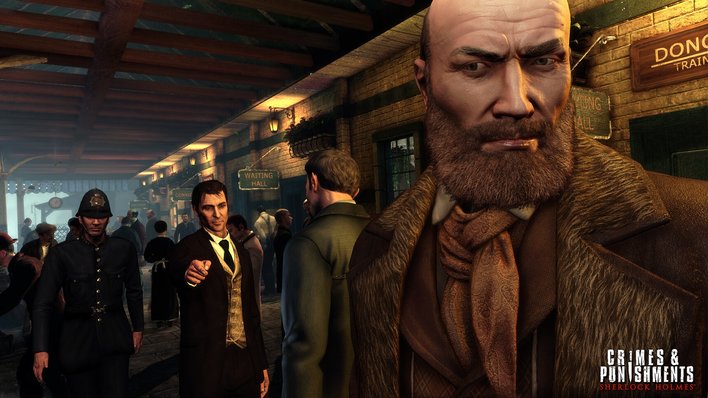Eccentric, anti-social and ludicrously clever. Conan Doyle's famous detective may never have worn a deer-stalker, uttered the words 'elementary my dear Watson' or studied the world through a giant magnifying glass, but he's not one of the world's most famous detectives for no reason. He's a formidable fighter and opium-addicted detective, who can solve anything he lays eyes on, with a pipe, cigar or other tobacco-based object stuffed in his mouth as he unravels the truth and bends the law to get to the bottom of each mystery. When he's not busy showing up Scotland Yard, he's usually kicking back with some cocaine, playing the violin or studying (and later keeping) bees. An unusual character, he's perhaps the best known detective ever, with scores of TV shows, films and spin-offs to his name - including the recent smash hit BBC Benedict Cumberbatch drama. He's even teamed up with Batman in an episode of 'Batman: The Brave and the Bold', although Conan Doyle had nothing to do with that one.
But long before the recent Sherlock revival, Ukrainian developer Frogwares have been making games staring the famous detective, with their latest - Crime & Punishments: Sherlock Holmes - due out in just a few months' time. As the name of the game suggests, Crime & Punishments is a detective game, focused on mystery, intrigue and investigation, relying more on brain power and the ability to puzzle your way out of a situation than on a quick trigger finger. A slow-paced adventure, you'll find yourself investigating crime scenes, piecing together evidence and interrogating suspects as you deduce your way through the game's six separate cases, solving anything from murders to mysterious disappearances to spectacular thefts - and everything in between.
Having already been shown around the game at last year's Gamescom trade show, our second hands-on with the title took us back to the same 'Murder of Black Peter' case - a rather strange case of an old sailor who's been pinned to the wall of his shed by one of his harpoons. Seeing as the weapon couldn't have found it's way through it's owner of it's own accord, foul play is definitely afoot, but with a crime scene that's stumped Scotland Yard, it's up to the most well-known fictional detective ever to get to the bottom of the grisly murder. Before we can even get that far, however, we need to help Watson get Holmes' attention - being the eccentric he is, he's decided to shut himself in his study, blindfolded, and take pot-shots at vases to pass the time, which means poor little Watson (with police inspector Lestrade in tow) must move from cover to cover, from behind tables to the backs of chairs, to reach his companion, and stir him from his trance-like state.

It seems Victorian London isn't the only place you'll be investigating...
Thankfully, even while blindfolded Holmes is a perfect shot, and Watson safely makes it across the room (thanks in no small part to some well timed clicking from us), only for Holmes to suddenly pause. As the camera pans to focus on Holmes, who curtly tells Watson to zip it, a series of characteristics appear next to him, as he apparently analyses the footsteps of the person who's approaching. With clicking handcuffs and an apparent aversion to the ninth step, Holmes quickly figures out it's Inspector Lestrade that's making his way into the room, catching the copper somewhat off guard in the process, but before long the pair are off to the scene of the crime to investigate.
It's a bit of a grizzly scene, as poor old Peter is found pinned to the wall of his shed, suspended above a pool of blood. Putting his detective hat on (metaphorically, there's no deerstalker here), it was now time for us to investigate the scene, and figure out exactly what went on. Clicking on anything that looks remotely interesting, we soon discover a number of useful titbits to help us on our way - from the weedy stabbing implement the poor bearded sailor tried to defend himself with, to the rather inconspicuous-looking tobacco pouch, with the initials 'P.C' embroidered on the front. The murdered man may have been Peter Carey, but after a short puzzle, in which you need to rotate a three-dimensional representation of the scent to reveal a hidden image, Sherlock deduces the particular blend of tobacco might be an important lead, jotting the details down in his casebook for reference later.
As perceptive an individual as ever, Sherlock has the ability to notice many things your average observer wouldn't. Despite the shared wisdom that you should do otherwise, he's capable of inferring a great deal about a person from looks alone, and during discussions with the game's many witnesses and suspects, you have the ability to profile them, piecing together aspects of their personality without so much as uttering a word. For example, a young street urchin's fancy jacket that's at odds with his other shabby clothes may set off alarm bells during an interview, whilst the reasoning behind a newly widowed woman's catholic rosary may give an insight into her past, or a guy's dirty, calloused hands might suggest he works as a gardener - all of which could throw up new avenues of investigation that were previously inaccessible.
Skipping ahead, we see Holmes and Watson experimenting at a nearby abattoir as they attempt to recreate the murder - after all, the easiest way to work out how hard it would be to impale someone on a harpoon is to try it yourself. With a pig's carcass hanging against the wall, it's time for Sherlock to follow in the footsteps of the likes of Telltale's The Walking Dead and Sony's Beyond Two Souls, with a little "quick time event". Known as QTEs, these little snippets usually involve pressing the correct button in time when a cue appears on the screen - in the case of our pig harpooning, that meant lining up a cross-hair with the target on the corpse, before setting the right amount of power behind your throw so as to send the weapon through the pig and into the wall behind. Bringing with them a smidge more action than we've grown accustomed to in the past, these little segments even include the odd punch up with a disgruntled sea man, who don't seem particularly chuffed at being accused of murder - win the fight and you can hand him over to the authorities, but lose and your suspect could escape instead...

One of many potentially disgruntled sailors...
And it's this choice and consequence system that's at the heart of Crime & Punishments, which gives you a number of different suspects to chose from, each with their own potential motives and reasons for committing the crime in question. Depending on how you chose to piece together the evidence and the deductions you make from each, a different guilty party may emerge, and the choice of who to condemn falls to Sherlock rather than Scotland Yard. Therefore, it's entirely possible to accuse the wrong guy and adversely effect Holmes' reputation, sometimes with unforeseen circumstances that Focus assure us "will force you to weigh up everything very carefully before acting". The game may be split into six separate cases, but we wouldn't be surprised if there were some common threads running through them all, with your actions in one having a direct consequence on a later investigation - for example, a crucial guy may be unwilling to cooperate with your investigation because you held his brother responsible for an earlier crime, or a witness you could have relied on met a grisly fate at the hands of the true murderer you never imprisoned, choosing to go with Joe Bloggs instead.
Of course, deciding who to blame as the guilty party isn't an easy task, and so it's therefore somewhat appropriate that it seems to be handled through a fairly complex looking, yet slightly easier to understand deductions board, which seems to bear more than a passing resemblance to a culture of bacteria (see the video below for footage of it in action). Here, it's up to you to match two pieces of evidence or clues together, which in turn will lead you to a deduction in one way or the other. Match everything up correctly, and you should be able to find out whodunnit - but as the game lets you make a false deduction, and Sherlock will fall for a red herring if you let him, you'll have to rely on your own intuition as opposed to a system of hand-holding.
Sure to have the same sort of grisly, gripping story as it's predecessors, getting to the bottom of each of the mysteries will likely take you a few play-throughs (assuming you don't have Sherlock levels of intuition, anyway), and with each case having up to six different conclusions, there's plenty of replay value here too. But for those of you that aren't as OCD as we are about seeing everything there is to see in your games, the folks at Frogwares have taken a leaf out of Telltale's book, telling you how many clues you found, and how many people decided to draw the same conclusion as you, letting you compare your logic skills with your friends. In an interesting twist, it's also possible to reveal who really did do it (albeit after having clicked through ample warning that what you're about to do may spoil your game experience), but we're think we'd rather just trust our instincts.
Crime & Punishments: Sherlock Holmes arrives this spring for the Xbox 360, Playstation 3 and Playstation 4, and is certainly shaping up to be another awesome instalment in the much-loved point-and-click series. Until then, we have a brand new trailer showing off the first few minutes of the game, some serious detective work and a glimpse at the famous private eye's brain:
















